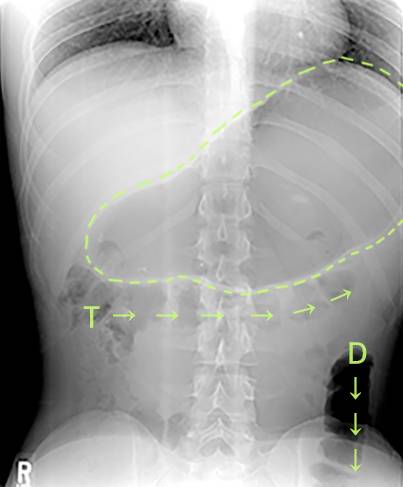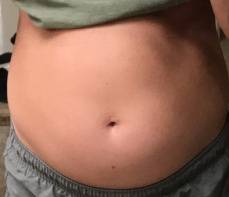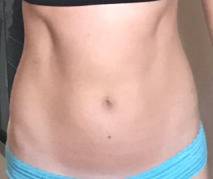Uno dei sintomi principali della R-CPD (incapacità di ruttare) è il gonfiore. Il gonfiore è spesso accompagnato da un’effettiva distensione addominale dovuta all’eccesso di aria sia nello stomaco che nell’intestino. Poiché la persona non è in grado di ruttare, l’aria deve ora passare attraverso l’intero tratto gastrointestinale ed essere dissipata come flatulenza.
Fotografie:
Gastric Air Bubble (1 of 3)
This abdominal xray of an individual with R-CPD shows a remarkably large gastric air bubble (dotted line), and also excessive air in transverse (T) and descending (D) colon. All of this extra air can cause abdominal distention that increases as the day progresses.
Gastric Air Bubble (1 of 3)
This abdominal xray of an individual with R-CPD shows a remarkably large gastric air bubble (dotted line), and also excessive air in transverse (T) and descending (D) colon. All of this extra air can cause abdominal distention that increases as the day progresses.
Bloated Abdomen (2 of 3)
Flatulence in the evening and even into the night returns the abdomen to normal, but the cycle repeats the next day. To ask patients their degree of abdominal distention, we use pregnancy as an analogy in both men and women. Not everyone describes this problem. Most, however, say that late in the day they appear to be “at least 3 months pregnant.” Some say “6 months” or even “full term.” In a different patient with untreated R-CPD, here is what her abdomen looked like late in every day. Her abdomen bulges due to all of the air in her GI tract, just as shown in Photo 1.
Bloated Abdomen (2 of 3)
Flatulence in the evening and even into the night returns the abdomen to normal, but the cycle repeats the next day. To ask patients their degree of abdominal distention, we use pregnancy as an analogy in both men and women. Not everyone describes this problem. Most, however, say that late in the day they appear to be “at least 3 months pregnant.” Some say “6 months” or even “full term.” In a different patient with untreated R-CPD, here is what her abdomen looked like late in every day. Her abdomen bulges due to all of the air in her GI tract, just as shown in Photo 1.
Non-bloated Abdomen (3 of 3)
The same patient, a few weeks after Botox injection. She is now able to burp. Bloating and flatulence are remarkably diminished, and her abdomen no longer balloons towards the end of every day.
Non-bloated Abdomen (3 of 3)
The same patient, a few weeks after Botox injection. She is now able to burp. Bloating and flatulence are remarkably diminished, and her abdomen no longer balloons towards the end of every day.


